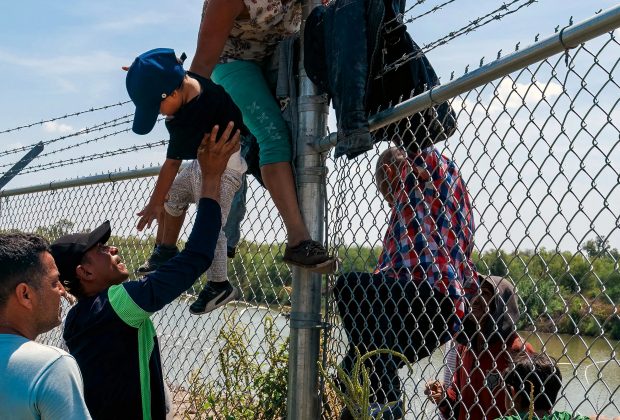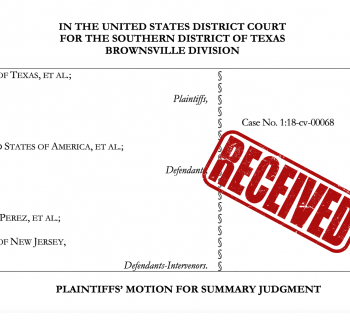Migrant children are drowning at the border. Their deaths are met with indifference. Rescue workers call these bodies “floaters.”
By Debbie Nathan | The Intercept | SEP. 2, 2023 | Photo by Suzanne Cordeiro
THE MEDIA WAS filled this summer with news of migrants blocked and wounded by orange buoys and sharp wire that the governor of Texas placed on the Rio Grande, the river bordering Mexico. A polltaken in August found that 51 percent of Americans approve of these hostile barriers — including four of every 10 Democrats. This is so even though it’s increasingly dangerous for migrants to try to enter the U.S. without going through official ports of entry. During the last three fiscal years, more people have died trying to cross the border than at any other time in recorded U.S. immigration enforcement history.
The dead include hundreds of adults who’ve expired from heat, vehicle collisions during Border Patrol chases, and mishaps in rivers — mostly the Rio Grande and its canals. Children, too, have died in droves, mainly by drowning. But as current polling suggests, you don’t have to like Donald Trump to be hostile or indifferent to this suffering.
Here are the children known to have drowned or disappeared in 2022, the last year with complete data, on the 55-mile length of the Rio Grande between the towns of Del Rio and Eagle Pass, Texas:
Victoria Mayor, 7, of Venezuela. Ismael Patiño, 4, from Uruguay. Angelica Silva, 4, Nicaragua. A 7-year-old boy from Angola; his 9-year-old brother also swept away but not reported found. Another 4-year-old Nicaraguan, no name provided to the media. A 3-year-old from Nicaragua and his 2-month-old brother dead weeks later of injuries sustained in the water. Christopher Alvarado, 14, from Honduras, drowned while trying to cross the river to reunite with his mother in Houston. A Cuban girl, 2. A 1-year-old from Brazil. A 9-year-old whose mother was trying to take her from rural Guatemala to Indiana. On Christmas Eve, an 8-year-old Nicaraguan boy.

This wave of child death has elicited nothing remotely comparable to the national outpouring of grief and anger that erupted in 2019 for Valeria Martinez. She was the 23-month-old Salvadoran toddler who died in the arms of her father, Oscar, as they tried to cross the Rio Grande to Brownsville, Texas. Their entwined bodies were photographed only minutes after they died. Valeria looked pristine, like a Victorian daguerreotype of a child just deceased from diphtheria. Her post-mortem intactness made her photo publishable, just as the image of Alan Kurdi, the 2-year-old Syrian refugee washed up on a beach in Turkey, was publishable in 2015.
But you will not see photos of the vast majority of children drowned at our southern border because they are deemed too grotesque for American media and its audience. “Floaters” is what rescue personnel call these bodies. They have been in the water for hours or days by the time they are retrieved. Their bellies, limbs, and faces are bloated, rotted to terrible distortion. Such was the appearance of a 5-year-old found in a border canal near El Paso in 2019, entangled with a drowned man whom authorities told the press was her father. It turned out that the two were not related. The little girl, from Central America, had crossed with her mother. Both had fallen into the canal, drowned, and floated downstream to where the canal forks. The mother went one way. The child went the other. Her corpse collided with that of the man, also from Central America. It took days to sort out the confusion. The error was never corrected in the media.
I got the photos months later because I had done an open records request for drowning death files for that year. Until then, only officers from the sheriff’s and coroner’s offices knew how the girl looked when she was pulled from the water. Her body had ballooned to almost twice the normal size, and one of her eyes was so bloated that it popped from its socket. She looked like a Cyclops.
I will not publish her post-mortem visuals. The child’s dad was in Central America when she died; I’m not in touch, and it would be up to him to request the photos and permit publication. And maybe it’s better that the U.S. public not view such images. Given the recent polling, it’s not clear that seeing them would improve America’s negative opinion about migrants — even though study after study has found that newcomers, legal and illegal, don’t take jobs from citizensand constitute a boon to the American economy. They pay more in taxes than they use in entitlements. We have a national labor shortage that they could help alleviate. But their fatalities during the crossing fail to move most of us. Nine migrants drowned in a single incident last September near Eagle Pass. Reporting on eight of the deaths before the ninth was discovered, the Washington Post called them the biggest mass drowning along the border in years. The article racked up 162 comments, many of them derisive:
poverty-ridden a$ylum scammer$ looking for a “better life”
Here come the Anchor-Babie$!
Play stupid games, win stupid prizes.
No sympathy at all for illegal people.
People dying for a free bus ride to Washington D.C. or NYC.
Where does this meanness come from? Why does it persist during the Biden administration and seem to be growing? A slim book published during the Trump administration offers an explanation.

It has a jarring title: “Cruelty as Citizenship: How Migrant Suffering Sustains White Democracy.” The conjoined words seem at first glance like oxymorons. Citizenship and cruelty? Democracy as something white?
The author, New York University political scientist Cristina Beltran, uses the German word “Herrenvolk” to anchor these connections, expanding it into a phrase: “Herrenvolk democracy.”
That term was first coined in the 1960s by anthropologist and sociologist Pierre van den Berghe. Herrenvolk means “master race,” and van den Berghe defined Herrenvolk democracy as a form of government regnant in South Africa under apartheid and in the slavery-based and Jim Crow United States until passage of the 1964 Civil Rights Act. Before 1964, people defined as white, male property owners (and later the white, male propertyless, and then white women) participated fully in voting and other perks of citizenship, while those considered less than white were, by law and everyday terror, denied voting and many other rights.
The former entitlements of Herrenvolk democracy for white Americans have created in many a profound sense of belonging, merit, and respect for traditionally Herrenvolk government. This, Beltran writes, is why many resent their beloved democracy’s extension to people historically considered nonwhite. It’s a zero-sum game for the Herrenvolk: What others gain, they lose. Despite the anxiety, even rage, elicited by this attitude, today it’s not acceptable for white-identified people to publicly impugn the civic merits of Black and brown Americans. After all, they are U.S. citizens. And the moral imperatives of the Civil Rights Movement are already almost boomer-aged: over six decades old.
This leaves one group to obsess about, resent, and disdain: a group with a long history of demonization in this country, who today remain susceptible to open expressions of Herrenvolk animus or, at best, indifference in the face of such hostility. That group is noncitizen people of color. In Herrenvolk thought, they are conscienceless Untermenschen, the Nazi term for inferior races. The have the temerity to traverse the border illegally and roam America at will, in brazen pursuit of the happiness of democracy — or, as Spanish-speaking immigrants often call it, el sueño americano, the American dream.
By law, immigrants who haven’t been naturalized are not citizens, and they live with highly restricted rights in America, whether they’re present legally or without authorization. They cannot vote. They can be deported for minor, nonviolent crimes, including those for which they’ve served their time. This is so even though millions of noncitizens, including those without papers, work and have U.S.-citizen kids and spouses. Beltran posits that it’s soothing, if not pleasurable, for Herrenvolk-identified people to scapegoat these newcomers, even as the Herrenvolk deem themselves committed partisans of democracy.
Beltran’s analysis extends these attitudes to some people of color. An exemplar is Republican presidential hopeful Vivek Ramaswamy. His South Asian-born parents immigrated legally to the U.S., and now he denounces immigrants crossing the border as an “invasion.” (Though his parents came here from India, he does not mention that Herrenvolk politics barred almost all South Asian Indian immigration to the U.S. from 1917 to 1965. Nor does he acknowledge the case of Bhagat Singh Thind, an Indian Sikh veteran of the U.S. military. He was naturalized as a U.S. citizen in 1920, but the Supreme Court revoked his citizenship three years later, deeming him not white according to “the understanding of the common man” in America.
Fear that people of color threaten white Americans is such a deeply engrained civic impulse that it sometimes runs independently of other feelings traditionally considered aspects of the culture wars. The New York Times recently polled Republicans about their views on abortion. Blue-collar white people living mainly in the U.S. Northeast constitute about a fifth of the party, and they overwhelmingly told pollsters they supported Trump. But a clear majority also said abortion should be legal, and that they supported same-sex marriage. At the same time, over a third said that the declining white share of America’s population was bad for the country. And here’s what they were even more willing to express openly: An overwhelming majority — 85 percent — said they opposed comprehensive immigration reform.
How else do Herrenvolk democrats publicly communicate their attitudes?
There are words. One is habitually used by Trump and his supporters and thus denounced by liberals: migrant “invasion.” There’s also the word that appears so habitually in mainstream media (AP, CBS News, ABC, NBC, MSNBC, Politico, WNYC host Brian Lehrer) that it’s normalized: “surge,” as in “the surge of migrants.” What’s wrong with “surge,” you might ask? It indicates something unexpected, sudden, and dangerous. In weather talk, it’s about flooding. In electrician talk, an uncontrolled power event that can crash your computer or burn down your house.
As for the media drumbeat about our “migrant crisis,” it echoes the now defunct “Negro problem” and Europe’s old “Jewish question.” The cause of the problem and the question wasn’t Black people or Jews; it was white racism and antisemitism. Today it’s not migrants. It’s the crisis of an embedded type of Americanism.

And there are visuals. Menacing rolls of concertina wire on the once sweet and welcoming Rio Grande. Images in the media of ever taller border walls, many originally erected years before Trump. A Department of Homeland Security video sent to reporters recently, showing an agent with grossly bulked muscles and “tactical-style,” bald-headed tonsure. His bicep is tattooed with blood-red swords, flames, and pitchforks — tattoos similar to those of the murderous Central American and Mexican gangs that migrants are often fleeing. The agent uses that arm to frisk a skinny youth and put him on a deportation plane to Guatemala.
Meanwhile, there’s quieter noise from those who nominally reject Herrenvolk democracy. New York City’s mayor, Eric Adams, says the community is depleted and can’t accept more migrants because there are no more beds in the shelters. He and Gov. Kathy Hochul ask President Joe Biden for federal funding and help to make the newcomers immediately eligible to work. Their petitions go largely unheeded. Meanwhile, no protest marches on Washington are organized from New York.
Some of my left-liberal friends wonder if their communities now have too large a “surge.” “Shouldn’t we spend our money,” they ask, “to shelter our own homeless?” These people think of themselves as fighters for social justice. Yet when it comes to immigration, they’re now thinking zero-sum and scapegoat. Such is the power of Herrenvolk democracy. Such is the need to face the floaters, including when they float within ourselves.







